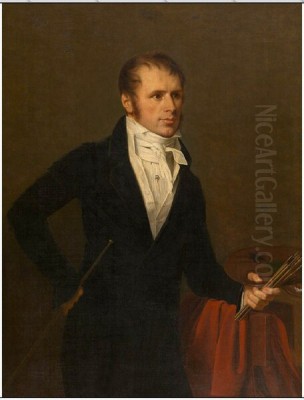
Jan Frans van Dael stands as a significant figure in the history of European art, particularly celebrated for his exquisite still life paintings. Active during a period of profound political and cultural transformation, spanning the late eighteenth and early nineteenth centuries, Van Dael carved a unique niche for himself. Born in the Flemish city of Antwerp, a historic cradle of artistic innovation, he eventually found fame and fortune in Paris, the vibrant heart of the European art world. His legacy rests primarily on his masterful depictions of flowers and fruits, works characterized by meticulous detail, luminous colour, and elegant composition. He was not only a painter but also engaged in decorative arts and lithography, showcasing a versatile artistic talent that earned him prestigious commissions and honours.
Early Life and Artistic Formation in Antwerp
Jan Frans van Dael was born in Antwerp on May 27, 1764. At this time, Antwerp, though past its absolute zenith during the era of Rubens and Van Dyck, still maintained a rich artistic tradition. Van Dael's initial training, undertaken at the Antwerp Academy of Fine Arts, was surprisingly not in painting but in architecture. This early grounding in architectural principles, with its emphasis on structure, form, and precision, may have subtly influenced the careful construction and balanced compositions evident in his later paintings.
However, the allure of painting proved stronger than that of architectural design. Van Dael transitioned his studies towards the pictorial arts, becoming a pupil of Andries Cornelis Lens (1739-1822). Lens was a prominent figure in Flemish Neoclassicism, known for his historical paintings and portraits, and his teachings likely instilled in Van Dael a respect for classical clarity and refined technique, even though Van Dael would ultimately specialize in a different genre. Antwerp's artistic environment, steeped in the legacy of masters like Jan Brueghel the Elder (1568-1625), renowned for his own detailed flower paintings, undoubtedly provided a rich backdrop for the young artist's development.
The Move to Paris and Decorative Beginnings
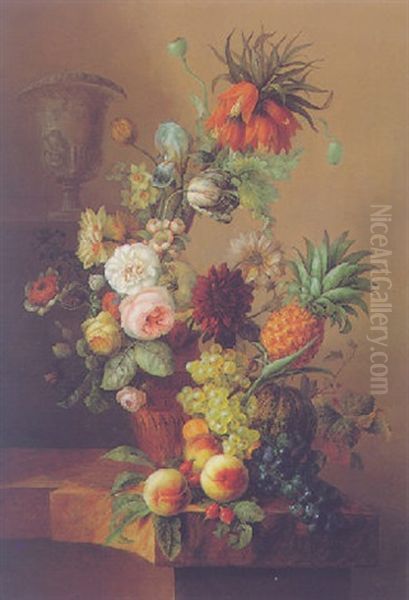
Around 1786, seeking broader opportunities and drawn by the magnetic pull of the French capital, Van Dael relocated to Paris. This move proved pivotal for his career. Paris was the undisputed centre of artistic life in Europe, offering access to patrons, influential academies, and the stimulating company of fellow artists. Initially, Van Dael found employment leveraging his earlier training, working as a decorative painter.
His skills were sought after for prestigious projects, contributing to the embellishment of luxurious residences and royal chateaux. Sources indicate he worked on decorative schemes at notable locations such as the Château de Saint-Cloud and the Château de Bellevue. This work involved creating ornamental designs, possibly including architectural elements, trompe-l'œil effects, and perhaps decorative floral motifs, which would serve him well in his future specialization. This phase provided practical experience and likely helped him establish connections within Parisian artistic and aristocratic circles.
Transition to Still Life Painting
While decorative painting provided a livelihood, Van Dael's true passion lay in easel painting, specifically the genre of still life. He gradually shifted his focus, dedicating himself to capturing the beauty of flowers and fruits with unparalleled precision. This transition coincided with a period where still life painting, particularly floral subjects, enjoyed considerable popularity, valued for both its decorative appeal and its technical challenge.
His decision to specialize was timely. The late 18th and early 19th centuries saw a surge of interest in botany and horticulture, fueled by scientific exploration and the cultivation of exotic plants. Wealthy patrons, including members of the French aristocracy and imperial court, were avid collectors of botanical art and luxurious floral still lifes. Van Dael's meticulous technique and elegant style were perfectly suited to meet this demand. He began exhibiting his still life paintings at the prestigious Paris Salon, the official art exhibition of the Académie des Beaux-Arts.
Artistic Style: Flemish Roots and Parisian Polish
Van Dael's artistic style is a harmonious blend of his Flemish heritage and the prevailing tastes of his adopted city. His work is deeply rooted in the Netherlandish still life tradition, which emphasized detailed realism, rich textures, and often, symbolic meaning. The influence of 17th-century Dutch and Flemish masters like Jan Davidsz. de Heem (1606-1684), Rachel Ruysch (1664-1750), and particularly Jan van Huysum (1682-1749), known for their elaborate bouquets and luminous finish, is evident in Van Dael's approach.
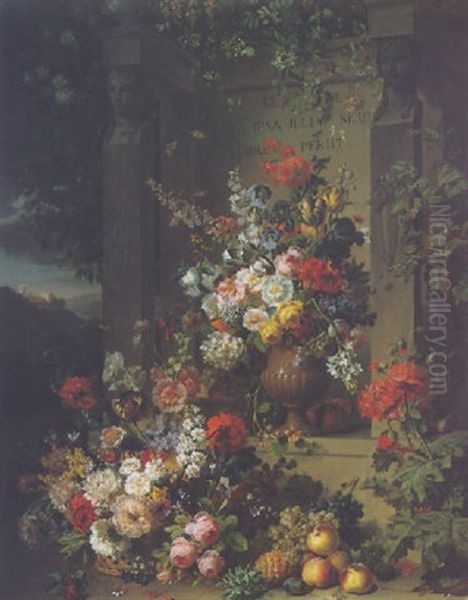
However, Van Dael did not merely replicate the past. He infused his work with a distinct refinement and elegance characteristic of French Neoclassicism and the burgeoning Romantic sensibility. His colours are bright and clear, yet harmoniously blended. He employed soft, diffused lighting to model forms gently, avoiding the dramatic chiaroscuro sometimes seen in earlier Baroque still lifes. His compositions, while often abundant, maintain a sense of balance and grace. The overall effect is one of naturalistic accuracy combined with an idealized beauty, appealing directly to the sophisticated tastes of his Parisian audience.
Mastery of Floral and Fruit Depiction
Van Dael excelled in the rendering of textures – the velvety softness of rose petals, the delicate translucency of grapes, the fuzzy skin of a peach, the cool smoothness of porcelain vases, or the rough texture of a marble ledge. He paid extraordinary attention to botanical accuracy, depicting each flower and fruit with scientific precision, yet never sacrificing artistic effect. His bouquets often feature a wide variety of species, showcasing both common European blooms and rarer, imported flowers, reflecting the horticultural interests of the era.
His compositions frequently include elements that enhance the illusion of reality and add layers of interest. Dewdrops clinging to petals, tiny insects like butterflies or ladybugs exploring the arrangement, or the subtle inclusion of a bird's nest add life and narrative potential to the scene. These details not only demonstrated his technical virtuosity but could also carry symbolic weight, alluding to themes of nature's bounty, the passage of time, and the fragility of life (vanitas), traditional concerns within the still life genre.
Contemporaries and Artistic Milieu
In Paris, Van Dael moved within a circle of highly accomplished artists, particularly those specializing in still life and botanical illustration. He shared a close friendship and professional association with Gerard van Spaendonck (1746-1822), another Netherlandish painter who had achieved great success in Paris as a flower painter and professor of floral painting at the Jardin des Plantes (the National Museum of Natural History). Their styles were often compared, both artists achieving remarkable realism and elegance, though Van Dael's work is sometimes considered slightly tighter in execution compared to Van Spaendonck's broader touch.
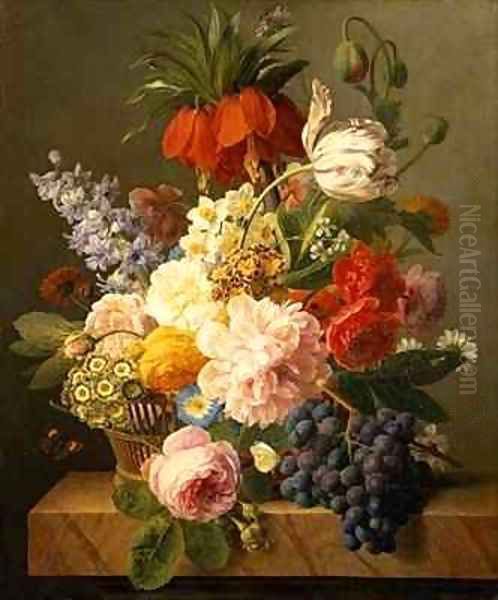
Another key figure in this milieu was Pierre-Joseph Redouté (1759-1840), often called the "Raphael of flowers." While Redouté was primarily known for his exquisite botanical watercolours on vellum, particularly his studies of roses and lilies commissioned by Empress Josephine, he and Van Dael operated in the same circles and catered to similar patrons. Their shared dedication to botanical accuracy and aesthetic beauty placed them at the forefront of floral art in their time. Van Dael's interactions with these artists, sharing techniques and exhibiting alongside them at the Salon, fostered a competitive yet mutually enriching environment.
Prestigious Patronage: The Imperial Court and Beyond
Van Dael's exceptional talent quickly attracted the attention of the highest echelons of French society. His most significant patrons were members of the French imperial family and the restored Bourbon monarchy. Empress Josephine Bonaparte (1763-1814), first wife of Napoleon, was a particularly important supporter. Known for her passionate interest in botany and her magnificent gardens at the Château de Malmaison, Josephine commissioned works from Van Dael, appreciating his ability to capture the beauty of her prized floral collections.
His patrons also included Napoleon's second wife, Empress Marie-Louise (1791-1847), and later, the Bourbon monarchs Louis XVIII (1755-1824) and Charles X (1757-1836). This consistent royal and imperial favour was a testament to the enduring appeal of his art across different political regimes. Such patronage not only provided financial security but also significantly enhanced his reputation, making his works highly sought after by collectors throughout Europe. His paintings became fixtures in imperial residences and aristocratic collections.
Salon Success and Official Recognition
Van Dael was a regular and successful participant in the Paris Salon, the most important venue for artists to display their work and gain public recognition. He began exhibiting there as early as 1793 and continued to do so for much of his career, until at least 1833. His meticulously crafted still lifes consistently drew praise from critics and the public alike.
His success at the Salon was marked by several official awards. He received a prize (reportedly a First Prize) in 1801, followed by Gold Medals in 1809 and 1810. These accolades solidified his standing within the Parisian art establishment. The ultimate recognition came in 1825 when he was awarded the Chevalier de la Légion d'Honneur (Knight of the Legion of Honour), France's highest order of merit. This honour underscored his status as one of the leading artists of his time, acknowledged not just for his technical skill but for his contribution to French cultural prestige. Exhibiting alongside giants of Neoclassicism like Jacques-Louis David (1748-1825) and later Jean-Auguste-Dominique Ingres (1780-1867), Van Dael held his own, demonstrating the continued vitality and appeal of the still life genre.
Representative Works: Monuments in Oil
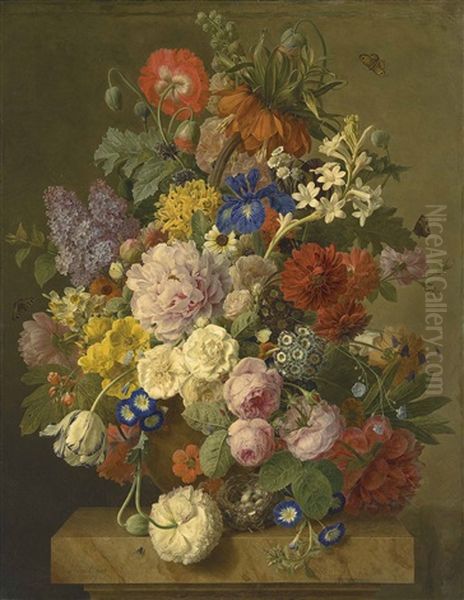
Several key works exemplify Jan Frans van Dael's artistry and achievements. One of his most famous paintings is Le Tombeau de Julie (The Tomb of Julie), now housed in the Musée du Louvre. This poignant work, sometimes interpreted as an allegorical tribute or memorial, possibly linked to Empress Josephine, depicts a lavish bouquet of flowers placed upon a classical altar or tomb structure. It masterfully combines floral beauty with a sense of solemnity and remembrance, showcasing his ability to imbue still life with emotional depth.
Another significant work often cited is Offrande à Flore (Offering to Flora). This title suggests a mythological or allegorical theme, likely depicting a rich arrangement of flowers presented as a tribute to the Roman goddess of flowers. Such works allowed Van Dael to display his virtuosity in rendering a wide array of blooms while engaging with classical themes popular during the Neoclassical era.
Other typical titles found in collections and auction records include Vase of Flowers, Grapes and Peaches, which highlights his skill in combining different types of natural elements within a single composition, balancing textures and colours. Vase of Flowers with a Broken Tuberose is noted as an example of his work, possibly hinting at vanitas symbolism through the broken flower stem, representing the transience of beauty and life. His ability extended to smaller formats as well; his miniature paintings on panel or copper were highly prized for their concentrated detail and jewel-like quality. A work titled Basket of Flowers and Fruit also appears, indicating his versatility in compositional formats.
Teaching and Lithography
Beyond his prolific output as a painter, Van Dael contributed to the arts as an educator and printmaker. He held a teaching position, likely succeeding his friend Gerard van Spaendonck, at the prestigious Jardin des Plantes in Paris. There, he instructed students in the art of flower painting, passing on his meticulous techniques and keen observational skills to a new generation. This role connected him directly to the scientific study of botany fostered by the institution.
Van Dael also practiced lithography, a printmaking technique that gained popularity in the early 19th century. While less known than his paintings, his lithographic work likely involved reproducing his own compositions or creating original botanical or floral prints. This engagement with printmaking allowed for wider dissemination of his imagery, contributing to his influence and reputation.
Influence and Legacy
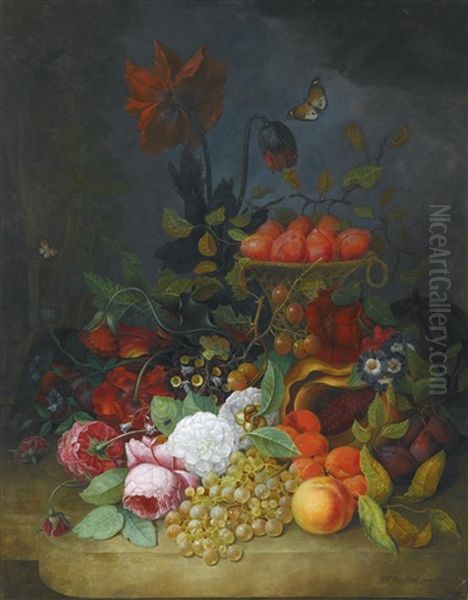
Jan Frans van Dael's influence extended through his students and the enduring appeal of his style. One documented pupil was Adèle Riché (1791-1878), who also studied under Gerard van Spaendonck and became a noted flower painter in her own right, known for detailed still lifes that clearly show the influence of her teachers. Van Dael's success, alongside Van Spaendonck and Redouté, helped sustain the high regard for floral and fruit still life painting well into the 19th century. His meticulous finish and elegant compositions provided a model for many subsequent artists specializing in the genre, both in France and his native Belgium. Other female artists like Henriette Vincent (1786-1834) were also active flower painters during this period, contributing to the genre's flourishing.
He continued to paint with remarkable skill into his later years, remaining active until shortly before his death. Jan Frans van Dael passed away in Paris on March 20, 1840, at the age of 75. He was buried in the Montmartre Cemetery, a resting place for many notable figures of French arts and letters.
Today, Van Dael's paintings are held in the collections of major museums around the world, including the Musée du Louvre in Paris, the Musée Boijmans Van Beuningen in Rotterdam, the Fitzwilliam Museum in Cambridge, the Château de Fontainebleau, and numerous other public and private collections. His works continue to be admired for their technical brilliance, botanical accuracy, and timeless aesthetic appeal. They stand as testament to a career dedicated to capturing the ephemeral beauty of the natural world with enduring artistry.
Conclusion: A Bridge Between Traditions
Jan Frans van Dael occupies a distinguished place in the history of still life painting. He successfully bridged the rich legacy of Flemish and Dutch realism with the refined elegance demanded by Parisian Neoclassical and early Romantic tastes. His move from Antwerp to Paris proved transformative, allowing his talent to flourish on an international stage. Through meticulous technique, a sensitive eye for colour and light, and prestigious patronage, he elevated the art of floral and fruit painting, creating works that were both scientifically observant and aesthetically captivating. His legacy endures not only in the exquisite paintings he left behind but also in his influence on subsequent generations of artists devoted to the beauty of the natural world. He remains celebrated as a master whose dedication to his craft produced some of the most accomplished and visually stunning still lifes of his era.